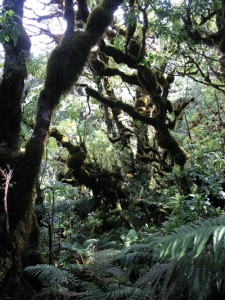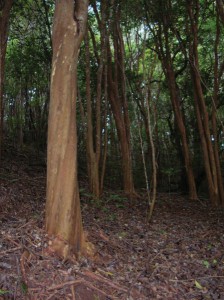
This rainforest, in Puu Kukui on West Maui, is an example of an open canopy rainforest typical of native rainforest in Hawaii. This forest acts like a ‘sponge,’ absorbing water from rain and gently releasing to recharge streams and aquifers. MISC file photo
When rain falls from the sky by the bucket-load it can be tempting to take water for granted, but the trip from raincloud to tap relies on effective, functioning natural systems. In Hawai‘i, alien plants disrupt the forest’s ability to capture water.
Water follows a cycle through the environment. Water over the ocean evaporates becoming atmospheric moister, as it travels over land it condenses into clouds, falling to Earth as rain or fog drip. Once on the ground, water has three paths: 1) it’s taken up by plants that use it to move nutrients through their cells, then return it to the atmosphere via transpiration; 2) it fills streams, lakes and rivers, eventually returning to the ocean–minus what was used for irrigation or lost through evaporation; or 3) it seeps through the soil into underground pools called aquifers. These aquifers supply most of the water we use to drink, bathe, and grow our food.
Forests have evolved differently to take advantage of prevailing water cycles in their regions. In South America and Africa the greatest diversity of plants is found up in the canopy. In Hawai‘i most plant species are found in the lower third of the forest, closer to the forest floor. Hawaiian understory plants need sunlight filtering through an open canopy. Koa and ‘ōh‘ia, the dominant Hawaiian canopy trees, grow in such a way that light reaches the shrubs and groundcover below.
Koa and ‘ōh‘ia pull water from passing clouds as fog drip; the curved leaves of koa provide surface area to collect moisture from clouds and channel it down leaf tips to the forest floor. Spongy plants on ‘ōh‘ia branches and trunks absorb moisture from passing clouds. Alien species disrupt the system.
Strawberry guava, Psidium cattleanium, has invaded Hawaiian rainforests, growing so dense and so

The invasive tree strawberry guava chokes out native plants. As it sheds bark, strawberry guava provides no habitat for the plants growing on the trunks of native species. Photo courtesy of Forest and Kim Starr.
fast that it chokes out other plants. A strawberry-guava-invaded forest captures water differently than our native forests. In Hawai‘i Volcanoes National Park researchers found that a forest dominated by strawberry guava delivered less water to the forest floor than an intact native rainforest. Researchers noticed several differences between the two forest types: more rain ran down the stems of strawberry guava than ‘ōh‘ia but less water was pulled from the passing clouds. This could result from structural differences. ‘Ōh‘ia have aerial roots and furrowed bark carpeted with mosses and small plants called epiphytes. The epiphytes and aerial roots soak up water from passing clouds. Strawberry guava bark is smooth and regularly shed; few plants grow on its trunk and branches.
Other invasive species disrupt the water cycle by sheer size—leaf size. Miconia trees with three-foot long leaves sweep into the forest, stealing light from the understory and transforming it into darkened forest, the soil bare but for miconia seedlings. As another researcher on Hawai‘i Island discovered, the huge leaves are more than just light-hogs. They collect water as if they were huge tarps, and, as anyone who has stood near the edge of a tarp in a rainstorm knows, it’s only a matter of time until the water
The forest floor under a miconia invasion is bare, often with exposed roots. Not a good sign for water collection. MISC file photo
dumps down. The drops running off of miconia turn out to be the largest drops ever measured. Larger drops hit the ground harder, and where miconia has smothered the understory, those drops fall on bare soil. Huge drops compact soil particles, preventing water from seeping down to aquifers, instead causing it to run off, carrying topsoil into streams and eventually the ocean where it can smother coral reefs.
These are only some of the ways invasive plants alter the forest’s ability to capture water. Water-hungry plants like Himalayan ginger pave the forest floor in tough roots. Huge trees like eucalyptus require more water to carry nutrients to their crowns than smaller trees. Unfortunately, the list goes on. Healthy forests mean reliable sources of water. Keeping invasive plants out of native forests is one way to help keep the water flowing from raincloud to tap
By Lissa Fox Strohecker. Originally published in the Maui News, March 11th, 2012 as part of the Kia‘i Moku Column from the Maui Invasive Species Committee
